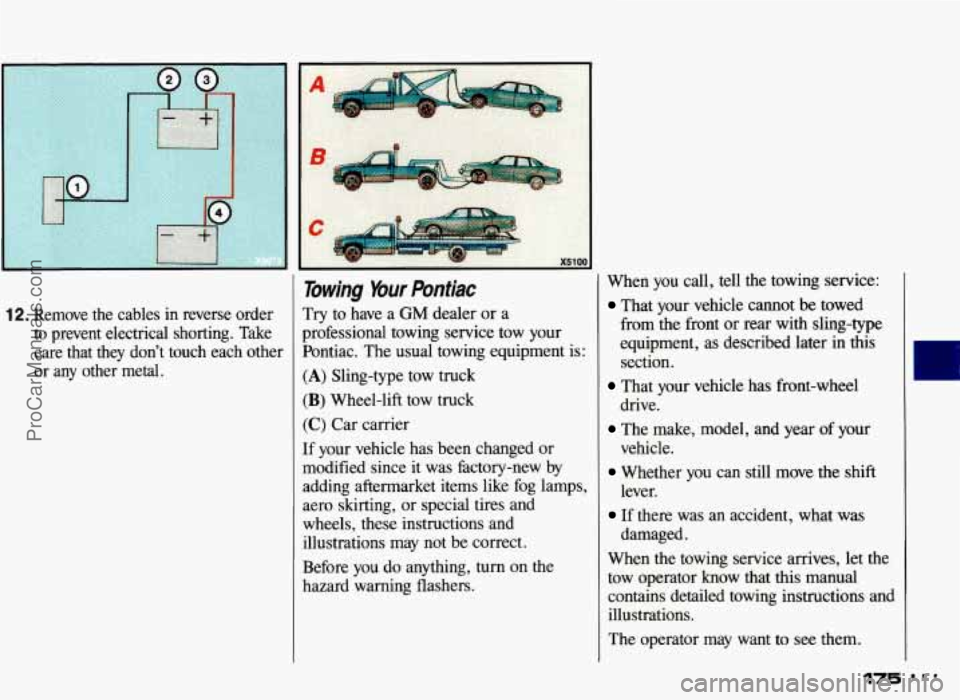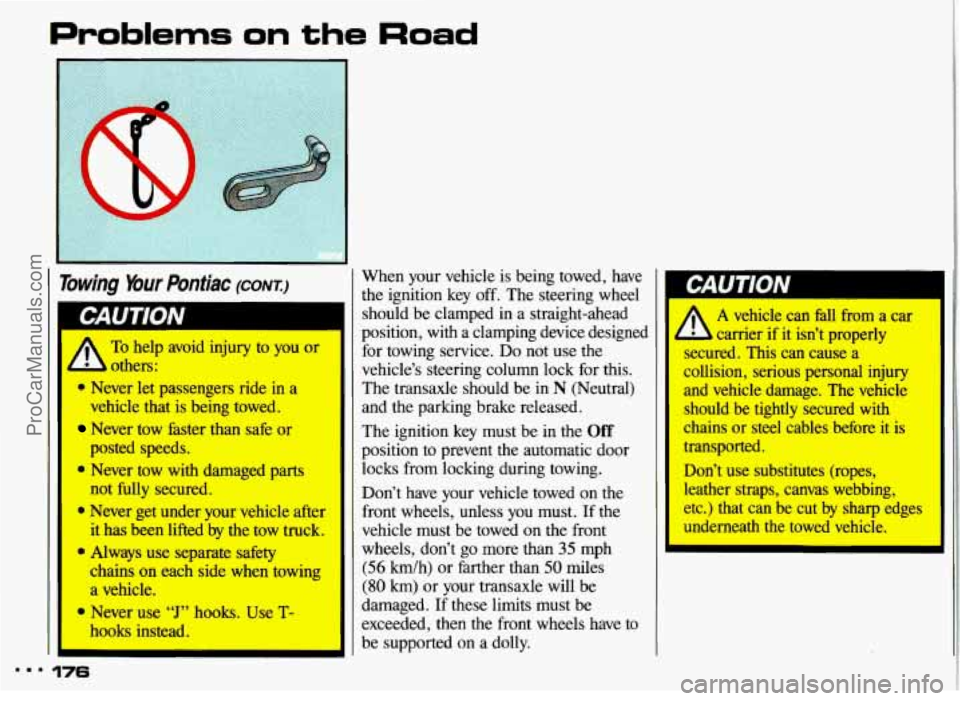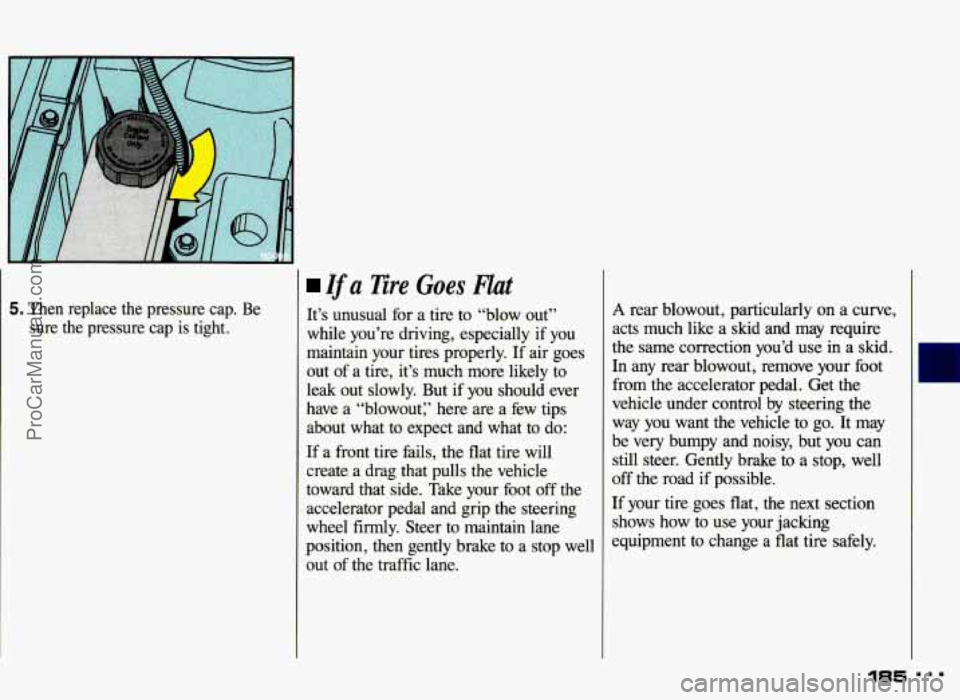Page 176 of 306

12. Remove the cables in reverse order
to prevent electrical shorting. Take
care that they don't touch each other
or any other metal.
lowing %ur Pontiac
Try to have a GM dealer or a
professional towing service tow your
Pontiac. The usual towing equipment is:
(A) Sling-type tow truck
(B) Wheel-lift tow truck
(C) Car carrier
If your vehicle has been changed or
modified since it was hctory-new
by
adding aftermarket items like fog lamps,
aero
skirting, or special tires and
wheels, these instructions and illustrations may not be correct.
Before you do anything,
turn on the
hazard warning flashers. When
you call,
tell the towing service:
That your vehicle cannot be towed
fram the front or rear with sling-type
equipment, as described later
in this
section.
drive. vehicle.
lever. damaged.
That your vehicle has front-wheel
The make, model, and year of your
Whether you can still move the shift
If there was an accident, what was
When the towing service arrives, let the
tow operator know that
this manual
contains detailed towing instructions and
illustrations.
The operator may want to
see them.
175 I..
ProCarManuals.com
Page 177 of 306

Problems on the Road
Towing Your Pontiac (CONT.:)
A others:
To help avoid injury to you or
0 Never let passengers ride in a
vehicle that is being towed.
Never tow faster than safe or
0 Never tow with damaged parts I
posted speeds.
0 Always use separate safety
chains on each side when towing
a vehicle.
hooks instead.
9 Never use “J” hooks. Use T-
... 176
When your vehicle is being towed, have
the ignition key off. The steering wheel
should be clamped
in a straight-ahead
position, with a clamping device designed for towing service.
Do not use the
vehicle’s steering column lock for this.
The transaxle should be
in N (Neutral)
and the parking brake released.
The ignition key must be in the
Off
position to prevent the automatic door
locks from locking during towing.
--
not fully secured. Don’t have your vehicle towed on the
Never get under your vehicle after front wheels, unless you must. If the
it has been lifted by the tow truck. vehicle must be towed on the front
wheels, don’t go more than
35 mph
(56 km/h) or farther than 50 miles
(80 km) or your transaxle will be
damaged. If these limits must be
exceeded, then the front wheels have to
be supported
on a dolly.
‘I
I‘
W
I A vehicle can fall from a car
b carrier if it isn’t properly
secured. This can cause a
collision, serious personal injury
I and vehicle damage. The vehicle
should be tightly secured with
chains or steel cables before it is
transported.
Don’t use substitutes (ropes, leather straps, canvas webbing,
etc.) that can be cut by sharp edges
underneath the towed vehicle.
ProCarManuals.com
Page 179 of 306
Problems on the Road
X5086
Towing from the Rear-
Vehide
Hook-Up
Before hooking up to a tow truck, be
sure to read all the information in
Towing bur Pontiac earlier in this
section. Also be sure to use the proper
hook-up for your particular vehicle.
Do not tow with sling-type
equipment or rear bumper valance
will be damaged. Use wheel-lift or
car carrier equipment (additional
ramping may be required for car
carrier equipment). Use safetv
chains and wheel straps.
1-
I
178
When using wheel-lift equipment,
towing over rough surfaces can
I
damage a vehicle. To help avoid
this, install a towing dolly beneath the wheels that would otherwise be
on the ground during the tow. This
will increase clearance between the
wheel-lift equipment and the
underbody of the towed vehicle. Attach
a separate safety chain to each
side
of the axle inboard of the spring.
ProCarManuals.com
Page 186 of 306

5. Then replace the pressure cap. Be sure the pressure cap is tight.
Ifa 3iii.e Goes Hat
It’s unusual for a tire to “blow out”
while you’re driving, especially
if you
maintain your tires properly.
If air goes
out of a tire, it’s much more likely to
leak out slowly. But if you should ever
have a “blowout:’ here are
a few tips
about what to expect and what
to do:
If a front tire fails, the flat tire will
create a drag that pulls the vehicle
toward that side. Take your foot
off the
accelerator pedal and grip
the steering
wheel
firmly. Steer to maintain lane
position, then gently brake to a stop well
out of the traffic lane.
A rear blowout, particularly on a curve,
acts much like a skid and may require
the same correction you’d use in a skid.
In any rear blowout, remove your foot
from the accelerator pedal. Get the
vehicle under control by steering the
way
you want the vehicle to go. It may
be very bumpy and noisy, but you can
still steer. Gently brake to a stop, well
off the road
if possible.
If your tire goes flat, the next section
shows how to use your jacking
equipment to change a flat tire safely.
185 I I..
ProCarManuals.com
Page 187 of 306
Problems on the Road
Changing a Flat lire
If a tire goes flat, avoid further tire and
wheel damage by driving slowly to a
level place. Turn
on your hazard
warning flashers.
186
IUII
Changing a tire can cause an injury. The vehicle can slip off the jack and
roll over you or other people. You and they could be badly injured. Find I
a level place to change your tire. To help prevent the vehicle from moving:
1. Set the parking brake firmly.
2. Put an automatic shift lever in P Wk). I
3. Shift a manual transaxle to 1 or R (Reverse).
4. Turn off the engine.
To be even more certain the vehicle won't move, you can put chocks at the
front and fear of the tire farthest away from the one being changed. That
would be the tire on the other side of the vehicle, at the opposite end.
ProCarManuals.com
Page 188 of 306
The following steps will tell you how to
use the jack and change a tire.
The equipment you’ll need is in the
trunk.
1. Turn the center retainer nut on the
compact spare tire housing
counterclockwise to remove it, then
lift the tire cover. You will find the
jaclung instructions label on the
underside
of the tire cover.
I
2. Remove the wing bolt securing the
compact spare tire, spacer and wheel
wrench by turning it counterclockwise.
Then lift
off the spacer and remove
the spare tire.
3. Remove the bolt securing the jack by
turning it counterclockwise. Then
remove the jack.
187
ProCarManuals.com
Page 189 of 306
Problems on the Road
Changing a Flat Tire (CONT.)
4. Remove the band around the jack.
Turn the jack handle clockwise to
raise the jack head a few inches.
L.. i
5. Using the wheel wrench, remove the
plastic cap nuts (if your vehicle has
them) and loosen all the wheel nuts. Don’t remove them yet.
On some models, a cover plate must
be removed to find the wheel nuts.
Carefully use the wedge end of the
wheel wrench
to pry it off.
6. Near each wheel, there is a notch in
the vehicle’s frame. Position the jack
under the vehicle. Raise the jack
head until it fits firmly into the notch in the vehicle’s frame nearest the flat
tire. Put the compact spare tire near
you.
ProCarManuals.com
Page 190 of 306
Ih Getting under a vehicle when
it is jacked up is dangerous. If
llle vehicle slips off the jack, you
could be badly injured or killed.
Never get under a vehicle when
it
is supported only by a jack. Raising your vehicle with the
jack
improperly positioned will damage
the vehicle or may allow
the
vehicle to fall off the jack. Be sure
to
fit the jack lift head into the
proper location before raising
vehicle.
Do not jack or lift vehicle using oil
pan. Pans could crack and begin to
leak fluid.
7. Raise tne venicle ~y rotating tne
wheel wrench clockwise. Raise the
vehicle far enough off the ground
so
there is enough room for the spare
tire to
fit.
8. Remove all of the wheel nuts, and
carefully pry the wheel cover from
the wheel,
if your flat tire has onp
Then take off
the flat tire.
189 I..
ProCarManuals.com